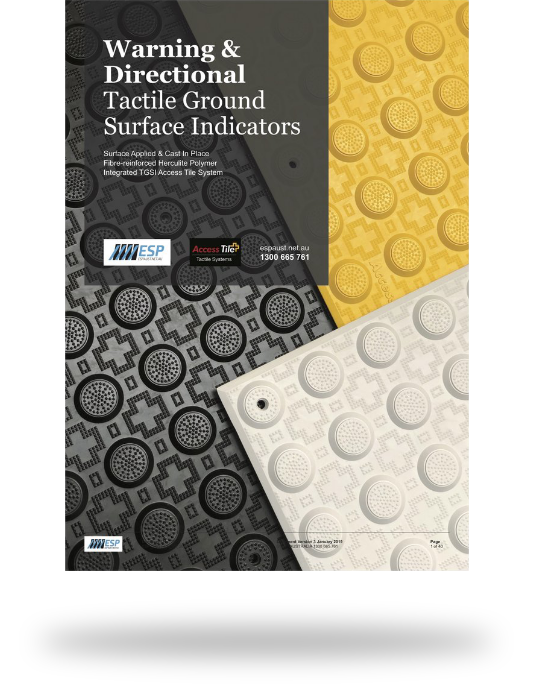ESP Australia’s Integrated Tactile Ground Surface Indicator (TGSI) systems, Surface Applied (SA) & Cast In Place (CIP) tiles have met stringent product and code compliance requirements required under Australian Law. These legislative mandates are also specified for installation, those who install them and person/s who direct or give instruction to others to apply these products. They are considered to be a ‘Duty Holder’ under Work and Health Safety (WHS) law within Australia.
We are committed to sharing our knowledge and expertise with our clients, team members and independent contractors. Our goal is to help you to comply with the laws and regulations that govern the use of TGSI’s. We have given extensive consideration to what it takes to be responsible and professional within the TGSI industry and how TGSI products work to serve the vision impaired.
ESP Australia has applied the Australian and New Zealand Standard AS/NZS 1428.4.1:2009 as a benchmark for all of its polices and procedures. We have created the following drawings (not to scale) to assist you in understanding the applicable Australian Codes and Regulations that govern the use of TGSI’s.
Please note that the information provided by ESP Australia is a summary of AS/NZS 1428.4.1:2009 and not a Standard. We strongly advise that each person obtain a copy of AS/NZS1428.4.1:2009 from Standards Australia. A copy can be purchased by visiting saiglobal.com.au
Warning Tactile Ground Surface Indicators
Warning / Hazard TGSI’s are truncated domes designed to warn pedestrians of hazards in the path of travel.

Note* Image not to scale
Stairs (Top & Bottom)
Diagram below: Set back 300mm +/- 10mm from the outer leading edge of the Stair Nosing, to a minimum depth of 600mm (Warning TGSI’s)

Ramp (Top & Bottom)
Diagram below: Set back 300mm +/- 10mm from the base of the incline (bottom) and top of the incline (top), to a minimum depth of 600mm (Warning TGSI’s)

Carriageways – Bus Stops
Diagram below: Set back 300mm +/- 10mm from the edge of the kerb, gutter or carriageway facing the bus up stream from the bus stop sign. Please Note* This will vary on the type of bus stop required. (Warning TGSI’s)

Carriageways – At the same grade as the pathway
Diagram below: Set back 300mm +/- 10mm from the edge of the carriageway, or adjacent hazard, without a physical kerb, gutter or barrier, to a minimum depth of 600mm. (Warning TGSI’s)

Carriageways – Kerb Ramps (Shallower than 1:8:5)
Diagram below: Set back 300mm +/- 10mm from the edge of the carriageway, or adjacent hazard, or from the nearest point of the start of the incline with or without a physical kerb, gutter or barrier, to a minimum depth of 600mm. (Warning TGSI’s)

Carriageways – Kerb ramp crossing at an angle (Shallower than 1:8:5)
Diagram Below: Set back 300mm +/- 10mm from the edge of the carriageway, or adjacent hazard with or without a physical kerb, gutter or barrier, to a minimum depth of 600mm. (Warning TGSI’s)

Escalator / Travelator
Diagram below: Set back 300mm +/- 10mm from the edge of the moving hand rail, to a minimum depth of 600mm (Warning TGSI’s)

Overhead Obstructions (Intersecting a continuous path of travel)
Diagram below: Set back 300mm +/- 10mm from the point where the obstruction has a clearance height of 2000mm or lower with no continuous accessible path of travel, to a minimum depth of 600mm (Warning TGSI’s)

Carriageways – Obstructed motorists vision
Diagram below: Set back 300mm +/- 10mm from the edge of the carriageway or adjacent to the hazard without a physical kerb, gutter or barrier, to a minimum depth of 600mm. (Warning TGSI’s)

Landings – Enclosed (Not accessible at any other angle of approach to the hazard)
Diagram below: Set back 300mm +/- 10mm from the edge of the hazard, to a minimum depth of 300mm (Warning TGSI’s)

Landings – Open (Open or accessible at any other angle of approach to the hazard)
Diagram below: Set back 300mm +/- 10mm from the edge of the hazard, to a minimum depth of 600mm (Warning TGSI’s)

Landings – Continuous / Unbroken Handrails
Diagram below: No Tactile Ground Surface Indicators are required.

Directional Tactile Ground Surface Indicators
Directional TGSI’s are a series of raised bars aligned to advise pedestrians of the direction of travel to a facility or point of service.

Note* Image not to scale
Diagram below: TGSI’s shall be installed parallel with and along the centre-line of the required path of travel. (Directional TGSI’s)

Diagram below: Where Directional TGSI’s indicate the continuous accessible path of travel, they shall be a minimum of 300mm wide. (Directional TGSI’s)

Diagram below: Where Directional TGSI’s need to be detected by a person approaching at an angle to the continuous accessible path of travel; they shall be a minimum of 600mm deep in the direction of approach.




